

II.2.7 CHIRAL Pd(0) AND Pd(II) COMPLEXES |
113 |
Chiral imidazolium or triazolium salt reacted with Pd(OAc)2 in the presence of NaI and KOtBu, giving a mixture of carbene–Pd complexes (Scheme 6).[51] These nucleophilic carbenes are regarded as replacements of phosphines with stronger Lewis basicity and attracted considerable attention recently.[52] The palladium complexes formed as mixture of cis and trans isomers, which were separable by column chromatography. Upon heating in DMF at 100 °C, the cis isomer is completely isomerized into the trans isomer. In these complexes, rotations around the carbene–Pd bonds are restricted, probably due to double bond characters of the C—Pd bonds, and several diastereomers were detected.
|
|
|
Ph |
|
|
|
|
|
|
Ph |
|
|
|
|
|
|
|
R* |
|
|||||
|
|
|
|
|
|
Ph |
|
|
|
|
|
|
|
|
|
|
|
|||||||
|
|
|
|
|
|
|
|
|
|
|
|
|
|
|
|
|
|
|
||||||
|
|
|
|
|
|
I |
N |
|
|
|
Ph |
|
|
|
|
|||||||||
|
|
N+ (ClO4–) |
|
|
|
N |
|
|
|
|
|
|
||||||||||||
|
|
|
|
|
|
|
|
|
|
|
|
|
||||||||||||
|
|
|
|
|
|
|
|
|
I |
N |
|
|||||||||||||
|
|
|
|
|
|
|
|
|
|
|
|
|||||||||||||
N |
|
|
N |
N |
|
|||||||||||||||||||
|
|
|
|
H |
|
Pd |
|
|
|
|
N |
N |
|
|
|
|||||||||
|
|
|
|
|
|
|
|
|
|
N |
+ |
|
Pd |
N |
||||||||||
|
|
N |
|
|
|
|
N |
I |
|
|
|
|
|
|
|
|
|
N |
||||||
|
|
|
|
|
|
|
|
|
|
|
|
|
|
|
|
I |
|
|
||||||
|
|
|
|
|
|
R* |
|
|
|
N |
|
|
|
|||||||||||
|
|
|
|
|
|
|
|
|
|
|
|
|
|
|
|
|
|
|
||||||
|
|
R |
* |
|
|
|
|
|
|
|
|
|
|
|
|
|
|
|
|
Ph |
|
|||
|
|
|
|
|
R* |
|
|
|
|
|
|
|
|
|
|
|
||||||||
|
|
|
|
Pd(OAc)2 |
|
|
|
|
|
|
R* |
|
|
|
|
|||||||||
|
|
|
|
|
|
|
|
|
|
|
|
|
|
|
|
|
|
|
||||||
|
|
|
|
|
|
|
|
|
|
|
|
|
|
|
|
|
|
|
|
|
|
|||
|
|
|
|
|
|
H |
NaI, KOtBu |
|
|
|
|
|
trans isomers |
|
|
|
|
|||||||
|
|
|
|
|
|
|
|
|
|
|
|
|
|
|
|
|
|
|||||||
|
|
|
|
|
|
Me |
|
|
|
|
|
|
|
|
|
|
|
|
|
|
|
|
|
|
|
|
–R* = |
|
|
|
|
|
|
|
|
|
|
|
|
|
|
|
|
|
|
||||
Ph
∆
|
|
Ph |
I |
|
Ph |
|
|
Ph |
|
R* |
|
R* |
|
|
|
|
|
|||||||
|
|
|
|
I |
|
|
|
|
|
Ph |
||||||||||||||
|
|
N |
I |
I |
||||||||||||||||||||
|
|
|
|
|
|
|
|
|
||||||||||||||||
N |
|
|
|
|
|
|
|
|
I |
|
|
|
|
|
|
I |
|
|
|
|||||
|
|
Pd |
N |
N |
N N |
|
|
|
N N Pd |
|
|
|||||||||||||
|
|
|
|
|
||||||||||||||||||||
|
|
|
|
|
Pd N |
N |
||||||||||||||||||
|
|
|
|
|
||||||||||||||||||||
|
|
N |
|
|
|
|
+ |
|
|
|
|
|
|
|
|
+ |
|
|
|
|
|
|
|
|
|
|
|
N |
|
N |
|
N N |
|
N |
|
N N |
|||||||||||||
|
|
|
|
|
|
|
|
|
||||||||||||||||
|
|
R* |
|
|
|
|
|
|
|
|
|
|
|
|
||||||||||
|
|
|
|
|
|
|
|
|
|
|
|
|
|
|
|
|
|
|
|
|
|
|
|
|
|
|
|
|
|
R* |
|
R* |
|
|
|
|
|
|
Ph |
|
|
|
|
|
|||||
|
|
|
|
|
|
|
Ph |
|
R* |
|||||||||||||||
|
|
|
|
|
|
|
|
|
|
|
|
|
|
|
|
|
||||||||
cis isomers
Scheme 6
Other miscellaneous examples of this series are listed in Figure 5.[7],[53],[54] Complex 22 showed large distortion from the normal square planar geometry, and the bite angle of the BINAP ligand (92.69°) was among the largest values for transition metal–BINAP complexes.[7]
Complexes 24, 25, and 26 all possess two neutral and two anionic ligands, respectively, and they are included in this section although they do not have halide ligands. Each of C2-symmetric bisoxazoline complexes 24 and 25 has two trifluoroacetate ligands and is a good catalyst for asymmetric Wacker-type cyclization.[55],[56] Complex 26, applied to the asymmetric Fujiwara–Moritani reaction, is a rare example of having anionic chelate
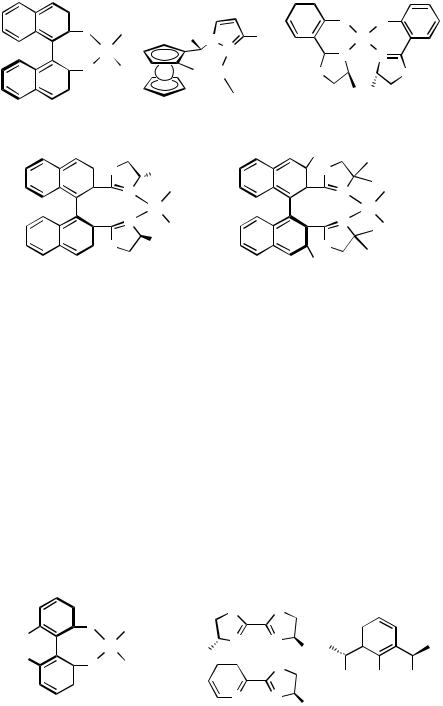
114 II PALLADIUM COMPOUNDS: STOICHIOMETRIC PREPARATION |
|
||||||||||||||
|
|
|
|
|
|
|
|
|
|
|
|
|
Tf |
Tf |
|
|
|
|
|
|
|
|
|
|
|
|
|
|
|||
|
Ph2 |
Cl |
|
|
|
|
|
|
|
|
|
|
N |
N |
|
|
P |
Me |
|
N |
Mes |
|
|
|
Pd |
||||||
|
|
Pd |
|
|
|
|
|
||||||||
|
|
|
|
|
|
N |
|
|
|
|
|
N |
N |
||
|
PPh2 |
Cl |
|
P |
|
Pd |
|
Cl |
|
|
|
||||
|
Fe |
|
|
|
O |
O |
|||||||||
|
|
|
|||||||||||||
|
|
|
|
|
Ph2 |
|
|
|
|
|
tBu |
tBu |
|||
|
|
|
|
|
|
|
|
|
|
||||||
|
|
|
|
|
|
|
|
Cl |
|
|
|
|
|
||
22 |
|
|
|
23 |
|
|
|
|
26 |
||||||
|
|
|
|
|
|
|
|
|
|
|
|
COOMe |
|
||
|
|
O |
|
iPr |
|
|
|
|
|
|
|
O |
|
||
|
|
|
|
|
|
|
|
|
|
||||||
|
|
|
N |
OCOCF3 |
|
|
|
|
|
N |
OCOCF3 |
||||
|
|
|
|
|
|
|
|
||||||||
|
|
|
N |
Pd |
|
|
|
|
|
|
|
|
|
N |
Pd |
|
|
|
OCOCF3 |
|
|
|
|
|
OCOCF3 |
||||||
|
|
|
|
|
|
|
|
|
|
||||||
|
|
O |
|
iPr |
|
|
|
|
|
|
|
O |
|
||
|
|
|
|
|
|
|
|
|
|
|
|||||
|
|
|
|
|
|
|
|
|
|
|
|
||||
|
|
|
|
|
|
|
|
|
|
|
COOMe |
|
|||
24 |
|
|
|
|
|
|
|
25 |
|
||||||
Figure 5
ligands.[57] The mechanistic study suggested that a species having only one ligand might be a real catalytically active species.
D.ii.b. Complexes with Carbon–Palladium -Bonds. Complexes having a hydrocarbyl ligand and a halide ligand are key intermediates of several Pd-catalyzed reactions (e.g., Heck reaction), although not many chiral species of this class are structurally characterized. Complex 27 (Figure 6) is one of the rare examples of these and represents a stabilized (by electronically with electron-withdrawing aryl group) intermediate of the asymmetric Heck reaction.[58] In 27, the Pd—P bond trans to the aryl ligand is lengthened, indicating strong trans influence from the aryl ligand. The methyl–chloro complexes 28 were converted to cationic species in situ and employed to asymmetric cyclization/hydrosilylation.[59] Complex 29 has a unique chiral PCP tridentate ligand, which is prepared via cyclopalladation.[60] The complex is C2-symmetric with two fused five-membered chelate rings. The two phenyl groups on the PPh2 moieties are in pseudoaxial and pseudoequatorial positions, respectively. The arrangement of the phenyl
|
Ph2 |
Ar |
|
|
|
O |
O |
|
|
|
|
|
||
|
|
|
|
|
|
|||||||||
|
P |
|
|
|
|
|
|
|
|
|
|
|
|
|
MeO |
|
|
|
|
N |
N |
|
|
|
|
|
|||
|
Pd |
|
|
|
|
|
|
|
|
|
||||
|
|
|
|
N = R |
R |
|
|
|
|
|
||||
MeO |
|
N |
|
|
|
|
|
|
||||||
|
PPh2 |
Cl |
|
|
|
|
|
O |
|
|
|
|
|
|
|
|
|
|
|
|
|
|
Ph2P |
|
|
Pd |
|
PPh2 |
|
|
|
|
|
|
|
N |
N |
|
|
|
|
|
||
Ar = p-MeO2C C6H4, C6F5 |
|
|
|
|
|
|
|
|
||||||
|
|
|
|
Cl |
||||||||||
|
|
|
|
|
R |
|
|
|
|
|
||||
27 |
|
|
|
28: PdMeCl(N N) |
29 |
|
||||||||
|
|
|
|
|
Figure 6 |
|
|
|
|
|
|
|
||
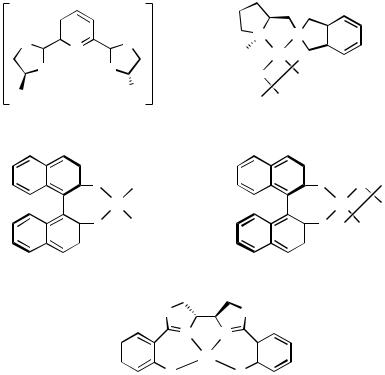
II.2.7 CHIRAL Pd(0) AND Pd(II) COMPLEXES |
115 |
groups is retained in the solution: the diastereotopic phenyls give two sets of resonances in the 1H and 13C NMR spectra.
D.ii.c. Cationic Pd(II) Complexes. The most preferred coordination number for Pd(II) complexes is four. When more than two neutral ligands coordinate to a divalent palladium, the complex becomes cationic. Anions such as halide can be potential ligands, which may replace the coordinating neutral ligands. To prevent the counteranions from coordination, weakly coordinating anions (noncoordinating anions) such as BF4 are frequently employed for these complexes.
The cis-N—Pd—N angles in 30 (Figure 7) are 79.5° and 81.8°, respectively, leaving a relatively large opening in the fourth coordination position for a potential reaction site upon dissociation of the acetonitrile.[61] X-ray crystallography of 31 reveals that the structure of the complex is C1 symmetric because of the bend of the chloride bridges.[62] This bent structure is retained in solution: 1H NMR gives two methyl signals with equal intensity. The aqua complex 32 and the hydroxo complex 33 were obtained from the same precursor PdCl2(binap).[63],[64] Treatment of the dichlorocomplex with AgBF4 in wet acetone gives 32. Reaction with additional molecular sieves 4A leads to 33. The counteranions in 34 are chlorides, which are potential ligands to the Pd.[65] The ionic form of 34 can be attributed to the chelate effect of the tetradentate ligand.
|
|
|
|
|
|
|
|
|
|
|
|
2+ |
|
|
|
|
|
|
|
|
|
|
2+ |
|
|||
|
|
|
|
|
|
|
|
|
|
|
|
|
|
|
|
|
|
|
|
|
|
|
|
|
|
|
|
|
|
|
|
|
|
|
|
|
|
|
|
|
|
|
|
|
|
|
|
|
|
|
|
|
|
|
|
|
O |
|
N |
|
|
O |
|
|
N |
|
N |
|
|
|
|
|
|
||||||||||
|
|
|
|
|
|
|
|
|
|||||||||||||||||||
|
|
|
|
|
|
|
|
Pd |
|
|
(BF4–)2 |
||||||||||||||||
|
|
|
|
|
|
|
(BF4–)2 |
|
|
|
|
|
|
||||||||||||||
|
|
|
|
|
|
|
|
|
|
|
|
||||||||||||||||
|
|
|
|
|
|
|
|
|
|
|
|
|
|
|
|
|
|
||||||||||
|
N |
|
|
Pd |
|
N |
|
|
Cl |
|
|
|
|
||||||||||||||
|
|
|
|
|
|
|
|
|
|
|
|
|
|
|
|
|
|
||||||||||
iPr |
|
|
|
NCMe |
iPr |
|
|
2 |
|
|
|
|
|
|
|
|
|||||||||||
|
|
|
|
|
|
|
|
|
|
|
|
|
|
|
|||||||||||||
|
|
|
|
|
|
|
|
|
|
|
|
|
|
||||||||||||||
|
|
|
|
30 |
|
|
|
|
|
|
|
|
|
|
31 |
|
|
|
|
|
|
||||||
|
|
|
|
|
|
|
|
|
|
|
|
|
|
|
|
|
|
|
|
|
|
|
|||||
|
|
|
|
|
|
|
|
|
|
|
|
|
|
2+ |
|
|
|
|
|
|
|
|
|
|
2+ |
||
|
|
|
|
|
|
|
|
Ar2 |
OH2 |
|
|
|
|
|
|
Ar2 |
H |
||||||||||
|
|
|
|
|
|
|
|
|
|
|
|
|
|
|
|
||||||||||||
|
|
|
|
|
|
|
|
|
|
|
|
|
|
|
|||||||||||||
|
|
|
|
|
|
|
|
P |
|
|
|
|
|
|
|
P |
O |
|
|||||||||
|
|
|
|
|
|
|
|
|
|
Pd |
|
|
(BF4–)2 |
|
|
|
|
|
|
|
Pd |
|
|
|
|
(OTf –)2 |
|
|
|
|
|
|
|
|
|
PAr2 |
OH2 |
|
|
|
|
|
|
|
PAr2 |
2 |
|
|
|
|
|||||
|
|
|
|
|
|
|
|
|
|
|
|
|
|
|
|
|
|
|
|||||||||
|
|
|
|
|
|
|
|
|
|
|
|
|
|
|
|
|
|
|
|
|
|
|
|
|
|||
|
|
|
|
32 |
|
|
|
|
|
|
|
|
|
|
33 |
|
|
|
|
|
|
||||||
|
|
|
|
|
|
|
|
|
|
|
|
|
|
|
|
|
|
|
|
||||||||
|
|
|
|
|
|
|
|
|
|
|
|
|
|
|
|
|
|
|
|
||||||||
|
|
|
|
|
|
|
|
|
|
|
|
|
|
O |
|
|
O |
|
|
2+ |
|
|
|
|
|
|
|
|
|
|
|
|
|
|
|
|
|
|
|
|
|
|
|
|
|
|
|
|
|
|
|||||
|
|
|
|
|
|
|
|
|
|
|
|
|
|
|
|
|
|
|
|
|
|
|
|
|
|||
|
|
|
|
|
|
|
|
|
|
|
|
|
|
N |
N |
|
|
|
|
|
|
|
|
|
|||
|
|
|
|
|
|
|
|
|
|
|
|
|
|
Pd |
|
|
|
|
|
|
(Cl–)2 |
|
|
|
|
|
|
|
|
|
|
|
|
|
|
|
|
|
|
|
|
|
|
|
|
|
|
|
|
|
|
|
|||
|
|
|
|
|
|
|
|
|
|
|
|
|
|
|
|
|
|
|
|
|
|
|
|
|
|||
|
|
|
|
|
|
|
|
|
|
|
|
|
|
P |
|
|
P |
|
|
|
|
|
|
|
|
|
|
|
|
|
|
|
|
|
|
|
|
|
|
|
|
Ph2 |
|
|
Ph2 |
|
|
|
|
|
|
|
|
|
|
|
|
|
|
|
|
|
|
|
|
|
|
34 |
|
|
|
|
|
|
|
|
|
|
|
|
|
||
Figure 7
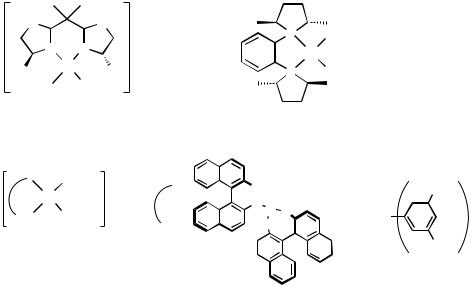
116 II PALLADIUM COMPOUNDS: STOICHIOMETRIC PREPARATION
O |
|
|
O |
+ |
|
|
|
|
|
P |
NCMe |
|
2+ |
|
|
|
|||
|
|
|
|
|
|
|
|
|
|
|
|
|
|||||||
|
N |
|
N |
|
BArF4– |
|
|
|
|
|
|
|
|
|
|
||||
|
Pd |
|
|
|
|
|
|
|
Pd |
|
|
|
(BF4–)2 |
||||||
|
|
|
|
|
|
|
|
|
|||||||||||
R |
|
R |
|
|
|
|
|
|
|
||||||||||
|
|
|
|
|
|
|
P |
NCMe |
|
|
|
|
|
||||||
|
|
|
|
|
|
|
|
|
|
|
|
|
|||||||
Me |
|
NCMe |
|
|
|
|
|
|
|
|
|
|
|
|
|
|
|
||
35: R = Me, iPr |
|
|
|
|
|
36 |
|
|
|
|
|
|
|
||||||
|
|
|
|
|
|
|
|
|
|
|
|
||||||||
|
|
|
|
|
|
|
|
|
|
|
|
|
|
|
|
|
|||
P |
Me |
+ |
P |
|
|
|
PPh2 |
|
|
|
|
|
|
CF3 |
|||||
|
|
|
|
|
|
|
|
|
|||||||||||
|
|
|
|
|
|
|
|
|
|
|
|||||||||
Pd |
|
|
|
|
|
|
|
|
|
|
|
|
|||||||
|
|
BArF4– |
= |
|
|
O |
P O |
|
|
|
|
|
|
|
|||||
|
|
|
|
|
|
|
|
|
|
|
F – |
|
|
– |
|||||
|
|
|
|
|
|
|
|
|
|
|
|
||||||||
OP |
NCMe |
OP |
|
|
|
|
O |
|
BAr 4 |
= B |
|
|
CF3 4 |
||||||
37 |
|
|
|
|
|
|
|
|
|
|
|
|
|
||||||
|
|
|
|
|
|
|
|
|
|
|
|
|
|
|
|
||||
|
|
|
|
|
|
|
|
|
|
|
|
|
|
||||||
Figure 8
An interesting application of cationic chiral Pd(II) complexes is copolymerization of olefin with carbon monoxide, which forms optically active, isotactic polyketones.[66]–[68] While complexes 35 and 36 (Figure 8) have C2-symmetric chiral ligands,[66],[67] the chiral ligand in 37 is unsymmetric C1 phosphine–phosphite with two independent binaphthyl skeletons.[68]
D.iii. Palladium Complexes with -Allyl Ligands
The -allylpalladium species is a very important class of compounds in organopalladium chemistry, which can be a catalyst and/or a key intermediate of a variety of reactions, such as allylation of nucleophiles and reduction of allylic esters with formic acid. Most of these reactions are now developed to asymmetric reactions using appropriate chiral ligands. Usually, the -allylpalladium complexes exist as rather complicated isomeric mixtures of stereoisomers as shown in Scheme 7, and controlling the equilibrium is one of the key factors to high stereoselectivity of the reaction. The isomerization of the-allylpalladium complexes proceeds via a so-called - - process, and a total of eight isomers is possible for the very general example described in Scheme 7. However, most of -allylpalladium systems studied in detail are not as complicated as Scheme 7. If the supporting ligands L1 and L2 are the same monodentate ligands or a C2-symmetric bidentate ligand, the bottom half of Scheme 7 can be negligible. Likewise, with certain substituted -allyl ligands (e.g. R1 R2), the isomerization becomes much simpler. In addition, in a system L1 L2, steric and/or electronic effects from the supporting ligands may disallow existence of certain isomers.
D.iii.a. -Allylpalladium Complexes with Chiral Monodentate Ligands. Several
-allylpalladium complexes with chiral monodentate phosphines are reported (38–43), Scheme 8.[69 ]–[74] In each complex, one equivalent of the phosphine ligand coordinates to

LigandsAllyl-
Pd(II)Chiral withComplexes
2.TABLE
Ref.
d NMR
c ray-X
b Reaction
Donor
a Chirality
Complex
69
H, P
y
reduction w/ formic acid
P
ax; binaphthyl (MOP)
70
H, P
y
reduction w/ formic acid
P
ax; binaphthyl (MOP-phen)
71
H, C, P
y
allylation
P
c; C (menthyl), P
72
y
hydrovinylation
P
c; C (menthyl), P
73
y
reduction w/ formic acid
P
ax; binaphthyl
74
H, P
y
hydrovinylation
P
c; P
75
H, P
y
allylation
P, P
c; C, pl; ferrocene
76
H, C, P
y
allylation
P, P
c; C
77
H
y
allylation
N, P
c; C (oxazoline)
H, C, P, noesy 78
y
allylation
P, P
c; C, pl; ferrocene
79
H, C, P
y
allylation
P, P
c; C
H, C, P, noesy 80
y
allylation
N, P
pl; ferrocene/ruthenocene c, pl; Fc-oxazoline
81
H
y
allylation
N, N
c; C
82
n
y
allylation
N, N
c; S (sulfoximine)
83
H
y
allylation
N, S
c; C
84
H, P
y
allylation
N, P
c; C (oxazoline)
85
y
allylation
N, P
pl; ferrocene,
86
C, H, P
y
allylation
N, P
ax; binaphthyl c; C (oxazoline),
87
y
allylation
P, S
ax; binaphthyl c; C
88, 91
H, C, P
y
allylation
P, P
c; C (chiraphos)
92,93 |
102,103 |
H,C,P H |
|
y n |
|
allylation |
allylation,Wacker |
|
3 |
P -C |
|
P, |
3 |
ax;binaphthyl(binap) |
c;C(chiral-allyl) |
104
H
n
Wacker
3 C- 3
allyl)- (chiralC c;
105 |
106 |
106 |
106 |
n H, C H, C H, C
n n y y
allylation |
|
|
|
3 |
3 |
3 |
3 |
-C |
-C |
-C |
-C |
3 |
3 |
3 |
3 |
-allyl) |
-allyl) |
-allyl) |
-allyl) |
c;C(chiral |
c;C(chiral |
c;C(chiral |
c;C(chiral |
38 |
39 |
40 |
41 |
42 |
43 |
44 |
45 |
46 |
47 |
48 |
49 |
50 |
51 |
52 |
53 |
54 |
55 |
56 |
57 |
58 |
59 |
60 |
61 |
62 |
63 |
64 |
Typeofchirality:c centralchirality(withcentralatoms),pl planarchirality,ax axialchirality. |
ReactionstowhichthePdcomplexesareappliedascatalysts/reagents. |
y:withX-raycrystalstructures,n:nocrystalstructure. |
NucleiwhoseNMRdataarereported. |
a |
b |
c |
d |
117
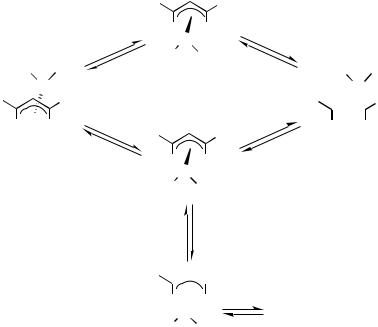
118 |
II PALLADIUM COMPOUNDS: STOICHIOMETRIC PREPARATION |
|
|
R1 |
R3 |
|
|
R2 |
R4 |
|
|
Pd |
|
L1 |
L2 |
L1 |
L2 |
|
|
||
R1 |
Pd |
|
|
R4 |
|
|
|
R2 |
R3 |
R2 |
R4 |
|
|
||
|
|
R1 |
R3 |
|
|
Pd |
|
|
|
L1 |
L2 |
R2 
 R4
R4
R1  R3
R3
Pd
L2 L1
Scheme 7
L1 L2
Pd
R2  R3
R3
R1 R4
in equilibrium with the other three isomers of the π-allyl ligand as shown above
the -allylpalladium moiety and the last coordination site is filled by a halide ligand. Thus, all the complexes are obtained as neutral species. The solution NMR studies of 38 clarified that the -allylpalladium complex existed as a mixture of the two diastereomers (Scheme 8).[69] The other possible isomers, in which the phosphine is trans to the CH2 moiety of the -allyl ligand, were not detected by NMR. Similar solution behavior was observed for 39 and 43 as well.[70],[74] Although analogous isomerization is assumed for all of the complexes in solution, the crystal structures of the complexes show the existence of only the major isomers in the solid state. Complexes 38, 39, and 42 were applied to asymmetric reduction of allylic esters with formic acid, in which use of monodentate chiral phosphine ligand was essential because of mechanistic requirement.[69],[70],[73]
D.iii.b. -Allylpalladium Complexes with Chiral Bidentate Ligands. The major part of the complexes in this category feature a distinctive steric characteristic: C1-symmetric supporting chiral ligands. In fact, many of chiral C1-symmetric bidentate ligands were designed and synthesized for the purpose of application to the -allylpalladium catalysts.
The concept of C2-symmetric ligands has widely been recognized as an ideal design of asymmetric ligands, which include DIOP, chiraphos, and BINAP. These ligands have been applied to a variety of transition metal-catalyzed asymmetric reactions and have been fairly successful. However, this situation is not always applied to -allylpalla- dium-mediated asymmetric allylic substitutions. In the reaction, which has been the most frequently examined asymmetric reaction catalyzed by -allylpalladium complexes, two factors need to be controlled for the sake of high stereoselectivity. One is
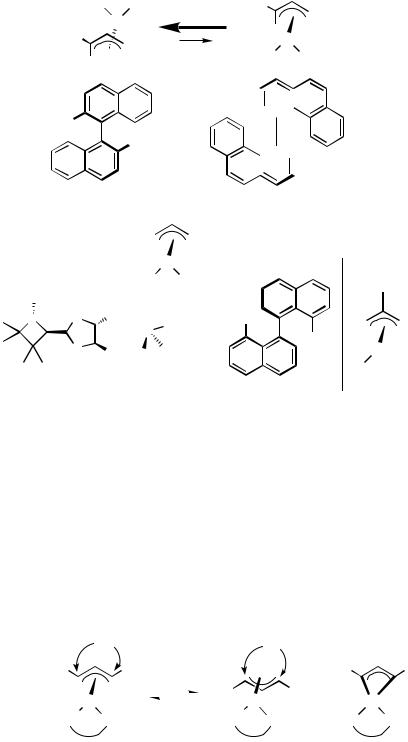
Cl L*
Pd
Me
Me
L* = |
MeO |
|
PPh2 |
||
|
X
menthyl |
|
|
P |
O |
Ph |
P
O |
Ph Ph |
|
|
40: X = Cl |
|
II.2.7 CHIRAL Pd(0) AND Pd(II) COMPLEXES |
119 |
Me
Me
Pd
Cl L*
MeO

(38) |
(39) |

 PPh2
PPh2
Pd |
|
|
L* |
|
|
|
|
|
O-menthyl |
MeO |
|
tBu |
|
PPh2 |
|
Pd |
|
Cl PCyPy(CH2Ph)
41: X = I |
42: X = Cl |
43 |
Scheme 8
the diastereomeric ratio between the two diastereomeric intermediates; the other is the position to which a nucleophile attacks (Scheme 9). The nucleophilic attack of soft nucleophiles comes from the opposite face of the -allyl moiety with respect to the palladium center. Since the reaction sites are apart from the chiral ligands (L1 and/or L2), steric control of the two reaction sites by the coordinating chiral ligand is not always easy. A solution to this problem is C1-symmetric bidentate ligand (L1 L2). The difference of electronic properties between L1 and L2 is transmitted to the two possible reaction sites of the -allyl ligand through the palladium center as a trans influence; then the electronic discrimination of the two reaction sites can be achieved.
R |
Nu |
R |
Nu |
|
R C1 |
C3 R |
||||
|
||||||||||
|
|
|
||||||||
|
Pd |
|
|
|
|
R |
Pd |
R |
Pd |
|
|
|
|
|
|
|
|||||
L1 |
|
|
|
|
L1 |
|
|
|||
L2 |
|
|
|
|
L2 |
|
L |
L' |
||
|
|
|
|
|
|
|
|
|
|
|
Scheme 9
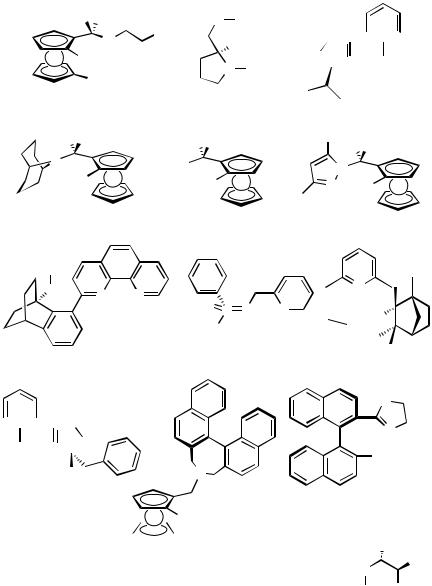
120 |
II PALLADIUM COMPOUNDS: STOICHIOMETRIC PREPARATION |
Some representative C1-symmetric bidentate ligands, of which X-ray crystal structures of -allylpalladium complexes are reported, are listed in Figure 9.[75]–[87] The magnitude of electronic discrimination between the two reaction sites in the -allyl ligands can be estimated by the difference of the bond lengths between Pd-C1 and Pd-C3 of the symmetric -allyl ligands (see Scheme 9). These values are 0.02 Å (44, R H),[75] 0.10Å (45, R Me),[76] 0.12 Å (46, R H),[77] 0.07 Å (47, R H),[78] 0.02 Å (48: M Fe,
|
Me H |
O |
PPh2 |
|
|
N |
OH |
H |
|
|
|
|||
Fe PPh2Me |
|
|||
|
N |
PPh2 |
||
|
PPh2 |
|
||
|
|
|
|
|
|
44 |
|
45 |
|
|
H Me |
H Me |
|
|
|
|
|
|
|
P |
|
Cy2P |
|
|
|
Ph2P Fe |
|
|
|
|
Ph2P |
|
M |
|
|
47 |
48 |
|
|
Me |
|
|
|
|
O |
N |
N |
|
|
|
|
|
||
|
|
O |
S |
N |
|
|
|
||
|
|
Me |
|
|
|
50 |
|
|
51 |

 O
O
PPh2 N
Me |
N |
53
54
 Fe
Fe PPh2
PPh2

 PPh2
PPh2
Figure 9
O

 N PPh2
N PPh2
46 |
|
Me |
|
H Me |
|
N |
|
N Ph2P |
Fe |
Ph |
|
49 |
|
N
N
 S
S
52
O
N  iPr
iPr
PPh2
55
Me
iPr
O
PPh2 S tBu
tBu
56
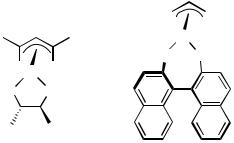
|
II.2.7 CHIRAL Pd(0) AND Pd(II) COMPLEXES |
121 |
R H),[79] |
0.05 Å (48: M Ru, R H),[79] 0.13 Å (49, R Ph),[80] 0.01 |
Å (51, |
R H),[82] |
and 0.12 Å (53, R H).[84] |
|
Although examples are few, there still are some interesting examples of -allylpal- ladium complexes with C2-symmetric bidentate chiral ligands. The first thorough investigation on solution behavior of chiral -allylpalladium complexes was done using the complexes of (S,S)-chiraphos, Ph2PC*HMeC*HMePPh2 (57, Figure 10).
The complexes were also employed as catalysts of asymmetric allylation. It was clarified that there was an approximate correlation of the enantioselectivity with the diastereomeric ratio of the corresponding -allylpalladium intermediates.[88] The solidstate structure of the chiraphos complex was later reported independently.[91] Examples of BINAP- -allylpalladium species are also known.[92],[93] The BINAP complex 58 was applied to catalytic asymmetric allylation using prochiral nucleophiles, -ac- etamido- -ketoesters, which gave chiral quaternary carbon centers with high enantioselectivity.[93]
Pd
Ph2P PPh2
Pd
Ph2P PPh2
57 |
58 |
Figure 10
As shown in Scheme 7, the solution behavior of -allylpalladium complexes is fairly complicated and analysis of the behavior is an interesting subject in conjunction with stereoselectivity of -allylpalladium-catalyzed asymmetric reactions. These studies are beyond the scope of this review. If interested, see the references.[94]–[101]
D.iii.c. Complexes with Chiral -Allyl Ligands. Chirality can be introduced to the
-allyl moieties of the palladium complexes. Some representative examples are shown in Figure 11. The chiral sources of these -allyl species are chiral terpenes. The terpenes ( )- -pinene, pinadiene (for 60), and ( )-3-carene (for 61) reacted with Pd(OAc)2 to give 59,[102],[103] 60,[104] and 61,[105] respectively. Meanwhile, these terpenes reacted with the palladium-hydride species generated in situ, giving ring opening products 62–64 in high yield.[106] These complexes were applied to Wacker-type oxidation[103],[104] or allylation of imines.[105]
D.iv. Miscellaneous Chiral Pd(II) Complexes
Unique helical chirality was induced in the backbone of poly[2,3-(1,4-diazanaphtha- lene)], which was prepared by Pd-catalyzed polymerization of 1,2-diisocyanoben- zenes.[107] The catalyst precursor was 65, which showed no helical chirality, and reacted 5

122 |
II PALLADIUM COMPOUNDS: STOICHIOMETRIC PREPARATION |
||||||||||||||||||||||
|
|
|
|
|
X |
|
|
|
|
|
|
X |
|
|
|
|
|
|
Cl |
||||
|
|
|
|
|
|
|
|
|
|
Pd |
|
|
|
|
Pd |
||||||||
|
|
|
|
|
Pd |
|
|
|
|
|
|
|
|
|
|||||||||
|
|
|
|
|
|
|
2 |
2 |
|
|
|
|
|||||||||||
|
|
|
|
2 |
|
|
|
|
|
|
|
||||||||||||
|
|
|
|
|
|
|
|
|
|
OMe |
|
|
|
|
|
|
|
|
|
|
|||
|
|
|
|
|
|
|
|
|
|
|
|
|
|
|
|
|
|
|
|
|
|
||
|
|
|
|
|
|
|
|
|
|
H |
|
|
|
|
|
|
|
|
|
|
|||
|
|
|
59: X = Cl, OAc |
|
|
60: X = Cl, OAc |
61 |
|
|
|
|
|
|
|
|||||||||
|
|
|
|
|
Cl |
|
|
|
|
|
Cl |
|
|
|
|
Cl |
|||||||
|
|
|
|
|
|
|
|
|
|
|
|
|
|
|
|
|
|
||||||
|
|
|
|
Pd |
|
|
|
|
|
Pd |
|
|
Pd |
||||||||||
|
|
|
|
|
|
|
|
|
|
|
|
|
|
|
|
||||||||
|
|
|
|
2 |
|
|
|
2 |
|
2 |
|
|
|
|
|
||||||||
|
|
|
|
|
|
|
|
|
|
|
|
|
|
|
|
|
|
|
|||||
|
|
62 |
|
|
|
|
63 |
|
64 |
|
|
|
|
|
|
|
|||||||
|
|
|
|
|
|
|
|
|
|
Figure 11 |
|
|
|
|
|
|
|
|
|
|
|||
|
|
|
|
|
|
|
|
|
|
|
|
|
|
|
|
|
|
PMe2Ph |
|||||
|
|
|
|
|
|
|
|
|
|
|
|
|
|
|
|
|
|
I Pd |
|||||
|
|
|
I |
|
Pd(PMe2Ph)n |
|
|
|
|
R |
Pd(PMe2Ph)I |
|
|
|
|
|
|||||||
|
|
|
|
|
|
|
|
||||||||||||||||
|
|
|
|
|
|
|
|
|
|
|
|
|
|
|
|
|
|||||||
|
|
|
|
|
|
|
|
|
|
|
|
|
|
|
|
|
|||||||
|
|
|
|
|
|
|
|
|
|
|
|
|
|
|
|
||||||||
|
|
|
R |
|
CN |
|
NC |
|
|
|
N |
N |
|
|
|
||||||||
|
|
|
|
|
|
|
|
|
|
|
|
|
|
|
|
|
|
|
|||||
|
|
|
|
|
Tol |
Tol |
|
|
|
Tol |
Tol |
|
|
||||||||||
|
|
R = MeO, H |
|||||||||||||||||||||
|
|
|
|
|
|
||||||||||||||||||
|
|
|
|
|
|
|
|
|
|
|
|
|
|
|
|
|
|
|
|
|
|
||
65 |
R |
|
|
= N |
66 |
|
Tol groups are omitted
Scheme 10s
equiv of the monomer to give a diastereomeric mixture of pentamer–Pd complexes 66. The diastereomers could be separated and the diastereomerically pure complex 66, which was still an active polymerization catalyst, gave the enantiomerically pure helical polymer (Scheme 10).
The 1,2-bis(methoxycarbonyl)-3,3-dimethylcyclopropene reacted with Pd2(dba)3 CHCl3 in acetone to give an enantiomeric mixture of the helically chiral palladacycle complex 67, which was solvated by acetone. The palladacycle reacted with ( )-DIOP to give a diastereomeric mixture of 68. The diastereomers were easily separated by HPLC, and removal of the DIOP ligand afforded the enantiomerically pure palladacycle (Scheme 11).[108] Using chiral C2-symmetric cyclopropenes (with chiral ester groups) in place of the achiral cyclopropene as a starting compound gave analogous chiral palladacycles with high diastereoselectivity.[109]
